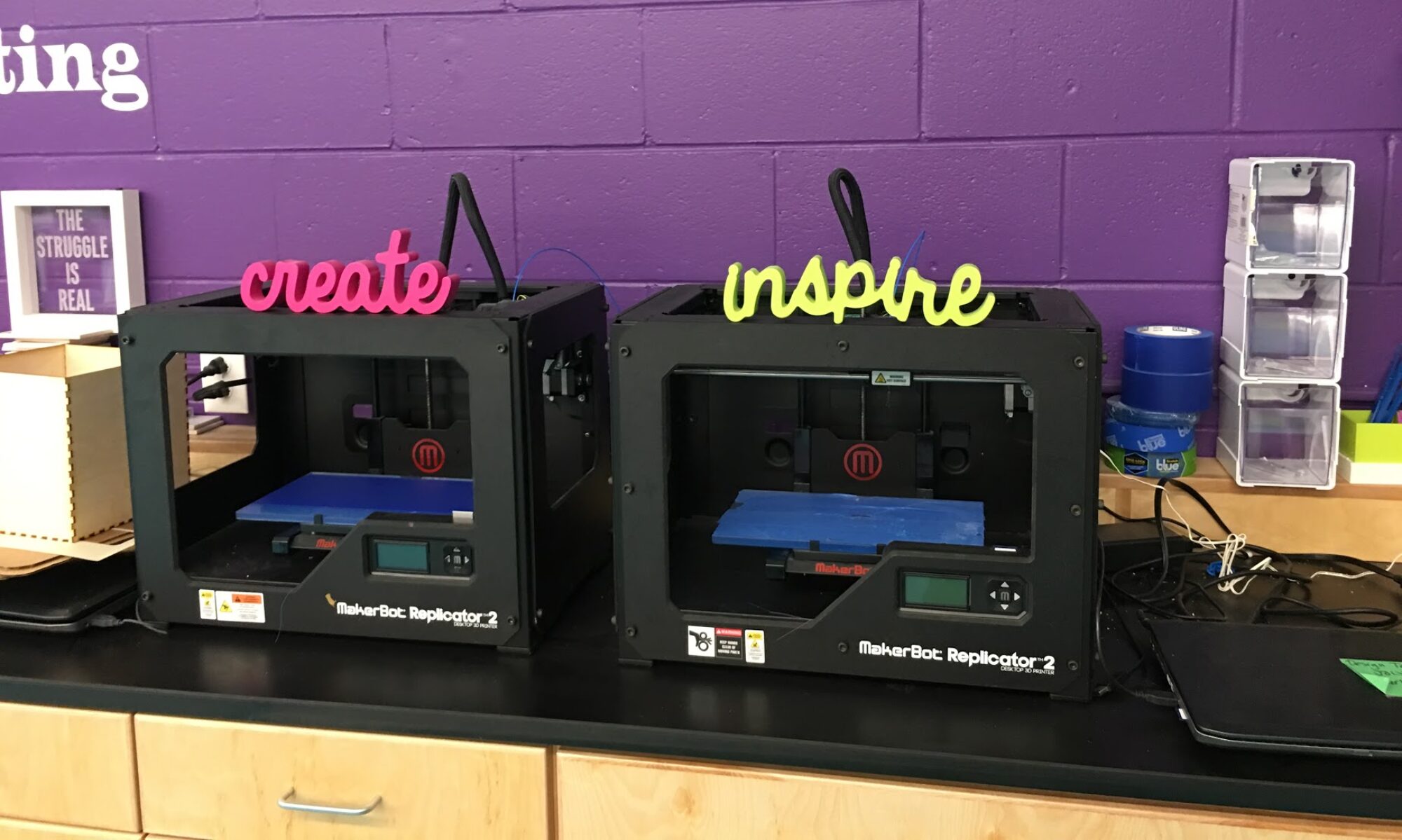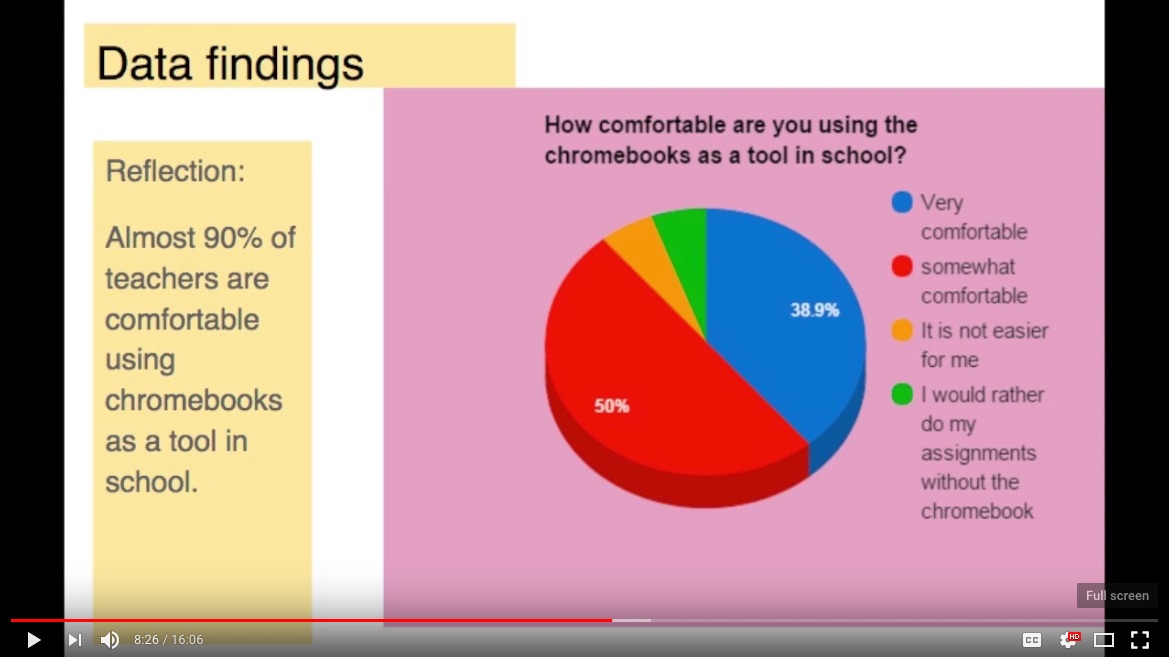How do student behaviors change?
 Debi Serafino, a math teacher at Brattleboro Area Middle School, presents the results of her semester-long action research project examining the effects of implementing 1:1 norms and digital citizenship on the behavior of the incoming 7th graders, all of whom participate in a 1:1 Chromebook project.
Debi Serafino, a math teacher at Brattleboro Area Middle School, presents the results of her semester-long action research project examining the effects of implementing 1:1 norms and digital citizenship on the behavior of the incoming 7th graders, all of whom participate in a 1:1 Chromebook project.
Here’s what she and her team discovered.

This work was presented at the 2016 Middle Grades Conference at the University of Vermont, and is highlighted here as one of our picks for powerful, transformative action research being done by Vermont educators. Full transcript below.

I teach at the Brattleboro Area Middle School, and I’m a math teacher there. We loop, so we have 7th and 8th grade, and currently this year I have 7th grade. We had a great commitment from the faculty at our school, that we had 17 teachers all attend the Middle Grades Institute (MGI) last summer, and we had done a 1:1 rollout the year before. It went really well, actually, for what the task was. At the same time, a year later, you think to yourself,
We can definitely refine this, and we should.
So when we were at MGI that was one of our missions: refine our 1:1 norms, and really try to have the students take more responsibility as far as being digital citizens, and also be more compliant with the teachers. The students definitely have more affinity with the technology — it’s even a little bit addicting, so they do what they want to do — but at school, we need them to realize they’re at school, and that needs to be what they focus their tasks on.
That became pretty important — not that we had a huge problem with it, but we could definitely see room for improvement, and that’s why so many of us were committing to refine those norms.
This year I teach the 7th grade, and we had a new group of students, so we knew we could start totally fresh. The 8th graders already had their Chromebooks, and a past performance — but we still apply our revised norms on them as well. But with the 7th grade we got to totally start with a year of experience behind us as well as a place from which to refine our norms.
Our goal was to have the students really see those Chromebooks as a tool for learning. I did an action research project, and this was its abstract:

In trying to get data, to really see if implementing the revised 1:1 norms and revised student incident log (we realized you have to have some accountability on the part of the students and the teachers — that also needed some revision), our vision was:
- What were our goals?
- What did we want to accomplish with the 1:1 program in our schools?
I used this document as a guide when it came to developing questions to include in my survey:

I sent that document out to the teachers because I wanted to see what the behaviors going on really were. All of us taught digital citizenship. Every teacher committed to teaching a part of digital citizenship. That was great in terms of seeing it come from all their teachers — not just core teachers but exploratory teachers as well, and special educators. Everyone did it.

We kind of broke up the digital citizenship curriculum and all volunteered for a part, and committed to teaching it. And in doing that, I created a Google Form based on some of the goals that arose from our vision statements; the ones that are underlined, above are the ones that went into the Google Form, they were the ones I targeted in my action research project.
- Time management: improvement on the part of the students
- Efficiency: in the 1:1. Would it result in the students being more efficient? Would it result in the classroom being more efficient?
- Responsibility: Would the students take responsibility, as far as using their Chromebooks, in a responsible way?
- Synthesizing/analyzing, being confident with making judgments about quality of information: That resulted from the digital citizenship curriculum we used. That was a really important part of digital citizenship.
- Responsible digital citizenship.
- Read an extended piece of text (multi-paragraph pieces of text): I love this one. I underlined this one because our English teacher really committed to this one, and he has some great work he’s done with students actually writing their own text, highlighting it, analyzing it. I know he’s worked very hard on that and done some great work in PLPs as far as providing evidence that speaks to that.
Another thing was that what we do as teachers, and what we ask them to do with the Chromebooks really needs to be relevant to them. And I think the work that we’ve done on PLPs I always think that and present that to the students. What they’re doing is relevant and they feel that.
During the first six weeks of school:

We revised the incident log. We started using it and quickly realized it wasn’t so great and quickly revised it. That was in the first week or two. And now it’s really a very good system. The team I’m on, we’re committed to using it pretty religiously, and I can tell you that sometimes when I have a student maybe leaving a Chromebook or something like that, I say
You need to do this, or I’ll have to record it in the Incident Log
and right away, boom, they do it. It changes their behavior and gets them back where they should be going.
Also, we went to 1:1 and the students also, after a period of time, like six weeks, we allowed the students to take them home, and I think that was a huge piece, because they really liked to take their Chromebooks home. So them ever losing the ability to take their Chromebook home, they really don’t want that to happen. That was a big piece of what came out of MGI.
Data Findings
These were some of the data findings in the research I did. For the first question I really just wanted to get a read on how comfortable the teachers in our school were with using Chromebooks, because it’s going to give me a window and insight into how they feel. Overall:

I think we have a mostly positive attitude as far as using the Chromebooks in our school, and I’m very pleased with that.
Another question that I had was “Do you feel the students are using their Chromebooks appropriately in class?” Because as much as you try, while you’re teaching in class you can’t see what they’re doing on those screens all the time. But if you’re going to use them, you’re going to really have to trust the students as well, because you want the lesson to move and you want them to learn certain things.

Just from my read on the school, having 56% of the teachers feel that students are using their Chromebooks appropriately in class is a huge improvement over the year before. Combined with the “Sometimes” numbers, that’s about three-fourths: three-fourths of the teachers feel that the students are using them appropriately. I see that as pretty positive.
In terms of who responded to this survey, most of the teachers in my school responded. This consists of the exploratory teachers, our special educators — everyone in the school did get the survey. We still have a little bit of work to do here, but this is definitely an improvement.
Another thing I looked at was whether the students are more compliant as compared to last year:

This can be something like: sometimes in my classroom I just want to get a quick assessment, so, “Go on your Chromebook,” ten minutes of assessment, close the Chromebook and move on. And when I ask them to close the Chromebook, I expect the Chromebooks to be closed. I shouldn’t have to repeat myself often, so we can move on and go the next activity. My experience in the class is pretty positive, and 72% is a great number.

70% of teachers said the students are more on-task than last year. And you have a variety of teachers responding; some could have really great engagement that they don’t see much of a change, but 70% do.
This one was interesting:

Estimate how often during class students are off-task on other sites, such as email. 25% doesn’t seem horrible to me, but having students be off-task only once per class or once per week is huge. We have our grading on Power School, they could be checking their grades on Power School. Generally, I think that’s pretty positive.

Only 10% reported students were not using the Chromebooks wisely. That’s pretty small, considering these responses came from pretty much all the teachers in the school.

If you combine the “absolutely” and the “sometimes” you have 90%. That was great.

This was kind of interesting. Students are using less paper (and hence more efficient), so thinking about language arts and social studies classes, it’s nice that they can revise revise revise before they print, and I think that’s why those numbers were so high. But one-third of teachers reported that there had been no change in terms of efficiency, but with a variety of classes, using the Chromebooks in all the classes, you might not see it happen the same in all the classes.

“Are students synthesizing, analyzing, being confident with making judgements about quality of information?” This was one of our goals, so as far as this response, this would be an area of growth we could target, and put something together to achieve a little better percentage around these skills. Still room for growth.
Conclusions

Based on the data, we definitely improved how we were doing from the year prior. We still have some areas of growth, but that’s in designing lessons, and it does come back to the teachers integrating technology into your curriculum so you provide those types of meaningful curriculum for the students to use.




Implementing 1:1 norms and digital citizenship #vted https://t.co/d5sjkf7q0a https://t.co/ipj0BIquSh
Implementing 1:1 norms and digital citizenship https://t.co/l713hRCoHx via @innovativeEd
RT @lifelegeros: Implementing 1:1 norms and digital citizenship https://t.co/l713hRCoHx via @innovativeEd